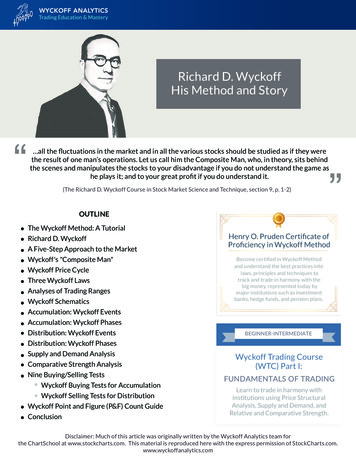
Transcription
Systems Archetype BasicsFrom Story to StructureDaniel H. KimAND Virginia AndersonPEGASUS COMMUNICATIONS, INC.Waltham, Massachusetts
1998 by Pegasus Communications, Inc.First printing May 1998 (3-ring binder)First printing February 2007 (softcover)Digital version December 2011 (PDF)All rights reserved. No part of this book may be reproduced or transmitted in any formor by any means, electronic or mechanical, including photocopying and recording, orby any information storage or retrieval system, without written permission from thepublisher. For additional copies, information about other titles published by PegasusCommunications, Inc., or general inquiries, contact:PEGASUS COMMUNICATIONS, INC.319 Littleton RoadWestford, MA 01866-4133 USAPhone 800-272-0945 / 781-398-9700Fax asuscom.comwww.pegasuscom.comISBN 101-883823-04-8ISBN 13978-1-883823-04-7Acquiring editor: Kellie Wardman O’ReillyProject editor: Lauren JohnsonProduction, art, and design: Boynton Hue StudioRevised editionPEGASUS COMMUNICATIONS, INC. is dedicated to providing resources thathelp people explore, understand, articulate, and address the challenges they face inmanaging the complexities of a changing world. Since 1989, Pegasus has workedto build a community of organizational learning practitioners throughThe Systems Thinker , Leverage Points for a New Workplace, New World newsletters,books, audios and videos, and its annual Systems Thinking in Action Conference,webinars and other events.
CONTENTSviiTo the Reader: Why Use This Book?Section 1About the Systems ArchetypesSection 2Fixes That FailSection 3Shifting the BurdenSection 4Limits to SuccessSection 5Drifting GoalsSection 6Growth and UnderinvestmentSection 7Success to the SuccessfulSection 8EscalationSection 9Tragedy of the Commons17254361738799111Section 10Using Archetypal StructuresSection 11Additional Learning Activities127139Appendix APotential Responses to the Learning ActivitiesAppendix BA Palette of Systems Thinking ToolsAppendix CSystems Archetypes at a GlanceAppendix DAdditional ResourcesAppendix EA Glossary of Systems Thinking Terms151177179183185v
TO THE READERWhy Use This Book?Congratulations! By picking up this book, you’ve taken a major step inlearning to use the systems archetypes. This powerful collection of systems thinking tools offers a highly effective way to grasp the complexitiesof organizational life and to address the stubborn, recurring problems thatoften confront us in the business world. Systems Archetype Basics: FromStory to Structure is designed to help you discover the principles of thearchetypes and begin actually using them. This workbook also builds onthe first volume in The Pegasus Workbook Series: Systems Thinking Basics:From Concepts to Causal Loops, which focuses on the foundational principles of systems thinking and introduces behavior over time graphs andcausal loop diagrams.Why Systems Archetypes?Why take time out of your busy schedule to read this workbook and complete the Learning Activities? Because the systems archetypes open a window onto important, recurring “stories” that happen in all walks of organizational life. The archetypes let us step back and see that manyorganizations—from small startups to huge, established companies—experience similar systemic challenges. Systems archetypes help usdeepen our understanding of these challenges and design effective actionplans for addressing them.How to Use This BookThere are many ways to present the systems archetypes. In this book, westart with the more familiar, accessible ones and work our way up to themore complex ones. For this reason, we recommend that you read the sections in numerical order, although you’re certainly free to choose a different order depending on your interests and familiarity with the material. We also hope that you’ll collaborate as often as possible with otherson the readings and the Learning Activities—working together oftenyields far more insights than puzzling through the concepts and exerciseson your own.Systems Archetype Basics begins with an introduction to the archetypesin general, including their history. The next eight sections explore thearchetypes one by one. Each of these sections follows a similar structure:They begin with a story that captures the “signature” dynamic of that particular archetype. They then explain the archetype’s storyline in generalterms and explore the typical behavior over time of that archetype. Next,the sections introduce the archetype’s systemic structure, or template, andshow how to map the opening stories onto the template. Each sectioncloses with tips for diagramming the archetype, a deeper look at what wevii
viiiTO THE READERcan learn from the archetype, and guidelines for managing the dynamicsof the archetype.Section 10 goes more deeply into the many rich ways you can use andapply the archetypes, including tips on detecting particular archetypes atwork. Section 11 contains additional Learning Activities for those readersinterested in more practice. Finally, the workbook closes with a set ofappendices that offer potential responses to all the Learning Activities, asummary of the 10 tools of systems thinking, a list of the archetypes “ata glance,” an additional resources list, and a glossary of systems thinkingterms.About the Learning ActivitiesMastering the systems archetypes requires lots of practice with real-lifeexamples. Accordingly, almost all the sections in this workbook contain awealth of illustrations from the business world and a series of LearningActivities that challenge you to apply your new knowledge. The LearningActivities can be done as self-study or in groups, though, again, weencourage you to work in groups as much as possible.These Learning Activities generally start with a story. Then, you’ll beasked to briefly summarize the archetypal theme in the story, identify keyvariables, graph the behavior of some of those variables over time, andcreate a causal loop diagram that depicts the archetypal, systemic structure manifested by the story. Each set of Learning Activities also ends witha special activity that invites you to choose a story from your own life thatyou feel demonstrates the particular archetype in question. As you complete these activities, remember that there are many ways to diagram asystem. Try to focus more on understanding the nature of the archetypesrather than diagramming them “correctly.” The Learning Activities, andthe potential responses to them, are meant to spark your imagination andserve as a starting point for you to think about the archetypes.AcknowledgmentsThe work contained in this book is built on the prior work of many others. First, we acknowledge Peter Senge for introducing the concept of system archetypes to a broad management audience in The Fifth Discipline.In many ways, the tremendous success of his book is what made the writing of this workbook possible in the first place. We also acknowledge allthose who were involved in the development of these principles and concepts before they ever appeared in The Fifth Discipline, including JohnSterman, John Morecroft, Michael Goodman, Jenny Kemeny, and DavidKreutzer. In addition, we thank Peter Stroh, Sherry Immediato, KristinCobble, Donella Meadows, and all the workshop participants and The Systems Thinker contributors who have given us valuable insights into understanding and applying the archetypes. Finally, we honor Jay Forrester'sbrilliance and insight in founding the field of system dynamics, which webelieve has much to contribute to the practice of management.
TO THE READERixIn addition, we’re deeply grateful to the following people for reviewing early drafts of the sections and offering helpful suggestions forstrengthening the presentation: Chaddus Bruce; Teresa Hogan, The CocaCola Company; Richard Karash, Karash Associates, Inc.; Renee Moorefield, The Coca-Cola Company; David Packer, the Systems Thinking Collaborative; Kristina Wile, the Systems Thinking Collaborative.At Pegasus, we thank Kellie Wardman O'Reilly for helping us to envision and initiate this project, and Lauren Johnson, whose tireless and persistent efforts as project manager and editor were instrumental in producing this book with high quality and in a timely manner. Thanks alsoto Cia Boynton, for creating the attractive design and transforming themanuscript into a book, and to Scott Young for coordinating the printingcycle.We hope you’ll find your adventure into using the systems archetypesstimulating and rewarding on both a personal and professional level. Wealso invite you to contact us with any comments, questions, or suggestions about using this book or about the archetypes in general.Enjoy!Daniel H. Kim(dhkim@alum.mit.edu)Virginia (“Prinny”) Anderson(VRAnderson@aol.com)
SECTION1About the SystemsArchetypesWHAT IS A SYSTEMS ARCHETYPE?Without having to climb beanstalks or push anyone into an oven, children learn lessons from fairy tales about how to hide from powerful, cruelbeings, build solid dwellings, and be respectful of old people. Literarythemes also show us the hero’s journey, the trials of hard work, the outcomes of faithful love and misguided passion, and the ennui of a materialistic life. In these examples from literature, the term archetype signifies arecurring, generic character, symbol, or storyline. In systems thinking, theterm has a very similar meaning. It refers to recurring, generic systemicstructures that are found in many kinds of organizations, under many circumstances, and at different levels or scales, from internal personaldynamics to global international relations.Captured in the stories, structures, and behavior over time of thearchetypes are similar teachings about competition, addiction, the perilsof quick fixes, and the high flyer’s downfall. And as we do with stories andfairy tales, we can use the archetypes to explore generic problems andhone our awareness of the organizational dramas unfolding around us.We can even use archetypes to sharpen our ability to anticipate difficulties, communicate about them with our colleagues, and find ways toaddress them together.The systems archetypes, as a group, make up one of the 10 currentcategories of systems thinking tools. (See Appendix B for a complete listof these tools.) Each archetype features a storyline with a distinctivetheme, a particular pattern of behavior over time that can be graphed,1
2SECTION 1 About the Systems Archetypesand a unique systemic structure that can be depicted in a causal loop diagram. The value of archetypes is that we can study them apart from a specific story, problem, or organizational situation and take away generic,transferable learnings that we can then apply to many situations in ourown lives.WHERE DID ARCHETYPES COME FROM?In the 1960s and 1970s, Jay Forrester, Dennis Meadows, Donella Meadows, and other pioneers of systems thinking observed several recurringsystemic structures. In the 1980s, Michael Goodman, Charles Kiefer,Jenny Kemeny, and Peter Senge built on that work, in part with the helpof notes developed by John Sterman, by describing, diagramming, andcataloguing these generic systemic structures as systems templates. WhenPeter Senge authored The Fifth Discipline: The Art and Practice of the Learn-A REVIEW OF CAUSAL LOOP DIAGRAMSCausal loop diagrams (CLDs) are graphic representations of our understanding of systemic structures.They’re valuable because they reveal our thinkingabout how the system is constructed and how itbehaves. When we share our CLDs with others,these diagrams become especially useful becausethey help us understand one another’s thinkingabout how the system in question works.Anatomy of a CLDCLDs consist of one or more feedback loops that areeither reinforcing or balancing processes. Each loopcontains variable names that represent componentsof the system that change over time, cause-andeffect relationships among the variables, and delays(see Figure 1.1, “A Simple Causal Loop Diagram”).In Figure 1.1, the system is depicted as onefeedback loop. The two variables that make up thissystem are “Level of Job Stress” and “Use of CopingStrategies.” The “s” and “o” designate how eachvariable affects the other. The “s” means change inthe same direction; “o” means change in the oppositedirection. To “read” this diagram, we would say, “Aslevel of job stress goes up, so does use of copingstrategies. As use of coping strategies goes up, levelof job stress goes down, after some delay.” Note thatwe could also start off by thinking of job stress asgoing down: “As job stress decreases, so does use ofcoping strategies. As use of coping strategiesdecreases, job stress might then rise againeventually.”Balancing and Reinforcing ProcessesFIGURE 1.1A Simple Causal Loop Diagramcause-and-effect notationsvariableLevel ofJob StressBUse of CopingStrategieslinkDelayobalancing process notationReinforcing and balancing processes are the buildingblocks of all the systems that we are part of and thatwe see around us. The “B” in the center of Figure 1.1signifies that this particular feedback loop representsa balancing process. A balancing process tries tobring the system’s behavior to a desired state andkeep it there—much as a thermostat regulates thetemperature in your house. These loops act as stabilizers within an overall system. In Figure 1.1, thelevel of job stress might therefore rise and fallsomewhat over time, but in the long run it wouldstay roughly the same, around some implicit or
SECTION 1 About the Systems Archetypes3ing Organization, he referred to those structures as systems archetypes.Since then, the notion of systems archetypes has become quite popularized, and systems thinking practitioners have continued to teach, apply,and write about these recurring generic structures as well as investigateand test the potential of identifying new ones.HOW CAN YOU USE THE ARCHETYPES?When you are tryi
field, The Coca-Cola Company; David Packer, the Systems Thinking Col-laborative; Kristina Wile, the Systems Thinking Collaborative. At Pegasus, we thank Kellie Wardman O'Reilly for helping us to envi-sion and initiate this project, and Lauren Johnson, whose tireless and per-sistent efforts as project manager and editor were instrumental in pro-ducing this book with high quality and in a timely .











